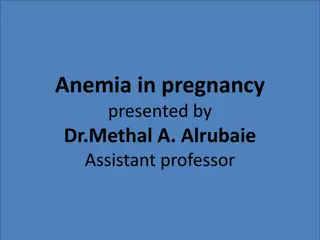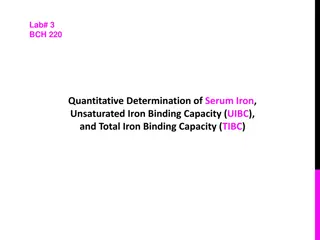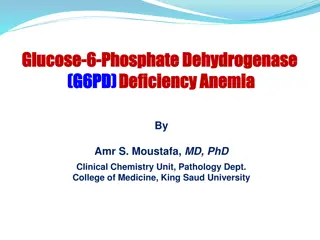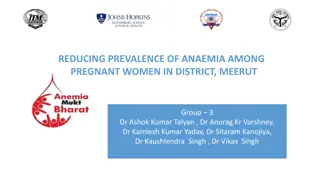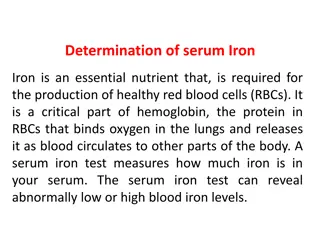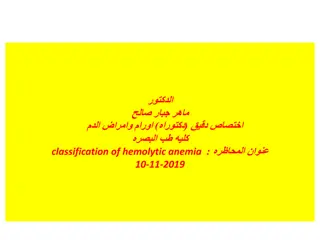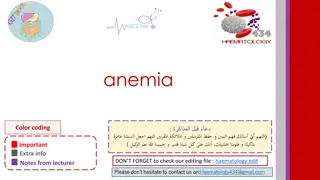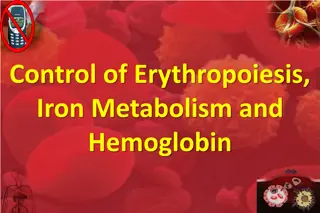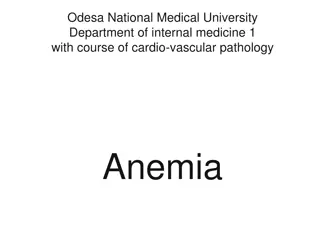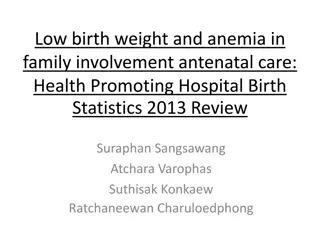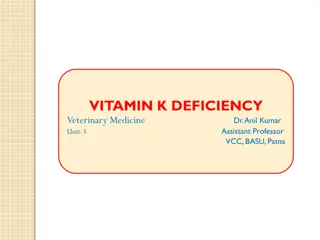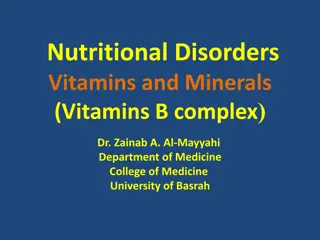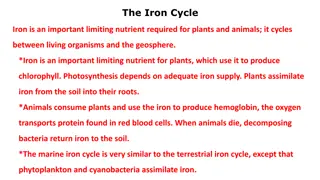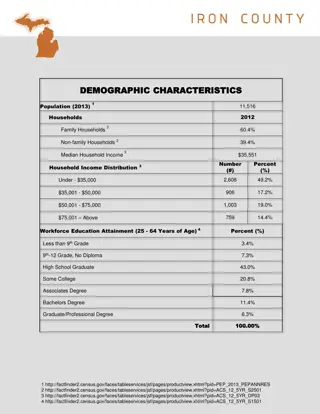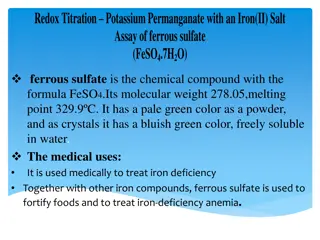Understanding Iron Deficiency Anemia and Therapy
Iron deficiency anemia occurs when the body lacks sufficient iron to produce hemoglobin, leading to symptoms like fatigue and weakness. Iron therapy, led by professionals like Dr. Haider Raheem, helps restore iron levels. Important information includes body iron distribution, absorption mechanisms, and dietary sources rich in iron to combat deficiency.
Download Presentation

Please find below an Image/Link to download the presentation.
The content on the website is provided AS IS for your information and personal use only. It may not be sold, licensed, or shared on other websites without obtaining consent from the author. Download presentation by click this link. If you encounter any issues during the download, it is possible that the publisher has removed the file from their server.
E N D
Presentation Transcript
Iron Therapy Dr. Haider Raheem
Iron Deficiency Anemia Iron deficiency is a state of negative iron balance in which the daily iron intake and stores are unable to meet the RBC and other body tissue needs. The body contains approximately 3.5 g of iron, of which 2.5 g are found in Hgb. A significant amount of iron is stored as ferritin or aggregated ferritin (hemosiderin) in the reticuloendothelial cells of the liver, spleen, and bone marrow and by hepatocytes. Ferritin circulates at concentrations that reflect total iron body stores. Only a small fraction of iron is found in plasma (100 to 150 mcg/dL), and most is bound to transferrin, the transport protein.
Table 6-1: Body iron distribution. Iron Content, mg Adult Male, 80 kg Adult Female, 60 kg Hemoglobin 2500 1700 Myoglobin/enzymes 500 300 Transferrin iron 3 3 Iron stores 600-1000 0-300
Iron Deficiency Anemia Despite the continuing turnover of RBC, iron stores are well preserved because the iron is recovered and reused in new erythrocytes. Only about 0.5 to 1 mg/day of iron is lost from urine, sweat, and the sloughing of intestinal mucosal cells that contain ferritin in men and in nonmenstruating women. Menstruating women lose approximately an additional 1 mg of iron per day. Pregnancy and lactation are other common sources of iron loss.
Iron Deficiency Anemia Individuals with normal iron stores absorb roughly 10% of ingested dietary iron. The average American diet contains 6 mg of elemental iron/1,000 kcal. Thus, an average daily intake of 10 to 12 mg is enough to replace the 1 mg lost daily. For menstruating, pregnant, or lactating women, however, the daily iron intake requirement may be as high as 20 to 30 mg.
Iron Deficiency Anemia Iron is absorbed from the duodenum and upper jejunum by an active transport mechanism. Dietary iron exists primarily in the ferric state and is converted to the more readily absorbed ferrous form in the acid environment of the stomach. The ferrous form binds to transferrin for transport to the bone marrow, where it is incorporated into the Hgb of mature erythrocytes. GI absorption of iron is increased from the usual 10% to as much as threefold to fivefold in iron-deficiency states or when erythropoiesis occurs at a more rapid rate. Animal sources of iron, heme iron, are better absorbed than plant sources, nonheme iron.
Table 6-2: Good sources of iron. Serving Size Food Amount (mg) Total cereal 1 cup 18 Grape-Nuts cereal 1 cup 18 Instant Cream of Wheat 1 cup 8.2 Instant plain oatmeal 1 cup 6.7 Wheat germ 1 oz. 2.6 Broccoli 1 medium stalk 2.1 Baked potato 1 medium 2.7 Raw tofu 1/2 cup 4 Lentils 1/2 cup 3.3 Beef chuck 3 ounces 3.2
Iron Deficiency Anemia A number of issues including disease, surgical bypass, a hypochloric state, infections, or drug food complexes can alter the absorption of iron. Anemia caused by iron deficiency is the most common nutritional deficiency worldwide. Although iron deficiency anemia has many causes, blood loss is considered one of the more common. Each milliliter of whole blood contains 0.5 mg of iron, whereas each milliliter of packed RBC (PRBC) contains 1 mg of iron. Common causes of chronic blood loss include peptic ulcer disease, hemorrhoids, ingestion of GI irritants, menstruation, multiple pregnancies, and multiple blood donations.
Iron Therapy Oral Iron Dosing H.P., a 31-year-old woman, is seen in the clinic. Her chief complaints include weakness, dizziness, and epigastric pain. She has a 5-year history of peptic ulcer disease, a 10-year history of heavy menstrual bleeding, and a 15-year history of chronic headaches. She has two children who are 1 and 3 years of age. H.P. is currently taking minocycline 100 mg twice daily (BID) for acne, ibuprofen 400 mg as needed for headaches, and esomeprazole 40 mg daily. A review of her systems is positive for decreased examination reveals a pale, lethargic, white woman appearing older than her stated age. Her vital signs are within normal limits; her heart rate is regular at 100 beats/minute. Her examination is notable for pale nail beds and splenomegaly. exercise tolerance. Physical
Iron Therapy Oral Iron Dosing Significant laboratory results include the following: Hgb, 8 g/dL Hct, 26% Platelet count, 500,000/ L Reticulocyte count, 0.2% MCV, 75 fL MCH, 23 pg/cell MCHC, 300 g/L Serum iron, 40 g/dL Serum ferritin, 9 ng/mL Total iron-binding capacity (TIBC), 450 g/dL 4+ stool guaiac (normal, negative) Iron deficiency is determined to be the cause of H.P. s anemia. An upper GI series with a small bowel follow-through are planned to evaluate her persistent epigastric pain. How should H.P. s iron deficiency be managed? What dose of iron should be given to treat H.P. s iron deficiency anemia and for how long?
Iron Therapy Oral Iron Dosing The primary treatment for H.P. should be directed toward control of the underlying causes of anemia, which in this case are many. H.P. s iron stores are low because of GI blood loss, multiple childbirths, heavy menstrual flow, decreased dietary iron absorption, and perhaps, an inadequate diet. Therefore, the cause of her GI blood loss should be corrected, her dietary intake should be analyzed and modified, and supplemental iron should be prescribed to replenish her stores and correct the anemia.
Iron Therapy Oral Iron Dosing The usual adult dose of ferrous sulfate is 325 mg (one tablet) administered two to three times daily, between meals. However, because of limited absorption of iron in the intestines, repletion with lower doses of iron has been shown to be effective, potentially minimizing side effects and improving compliance. If no iron is being lost through bleeding, the required daily dose of elemental iron can be calculated using a formula that assumes that 0.25 g/dL/day is the maximal rate of Hgb regeneration.
Iron Therapy Oral Iron Dosing Elemental iron (mg/day) = 0.25g Hgb/100 mL blood/day (5,000 mL blood) (3.4 mg Fe/1 g Hgb) = 40 mg Fe/day/20% absorption (approximate absorption rate in iron- deficient states) = 200 mg Fe/day = 1,000 mg ferrous sulfate/day (ferrous sulfate contains 20% elemental iron) = 325 mg three times daily (TID) ferrous sulfate
Product Selection What are the differences between iron products? Which is the product of choice? The ferrous form of iron is absorbed three times more readily than the ferric form. Although ferrous sulfate, ferrous gluconate, and ferrous fumarate are absorbed almost equally, each contains a different amount of elemental iron that is available for absorption. Carbonyl iron, another iron product, is available, but its use may be limited owing to the fact that iron in this form must be solubilized by gastric acid to be absorbed. Table 6-3 compares the iron content of several oral iron preparations to assist in making appropriate treatment choices for patients.
Table 6-3: Comparisons of iron preparations. Preparation Dose (mg) Fe2+Content (mg) Fe (%) Ferrous sulfate 325 65 20 Ferrous fumarate 324 106 33 Ferrous gluconate 300 34 11 Carbonyl iron 45 Slow Fe (time-released) 160 50 31
Parenteral Iron Therapy Indications When would parenteral iron therapy be indicated for H.P.? Several indications exist for parenteral iron administration. Failure to respond to oral iron therapy would prompt a reevaluation of H.P. Causes of oral therapy failure can include nonadherence, misdiagnosis, inflammatory conditions, malabsorption radiation enteritis, gastric bypass), the need for rapid iron repletion, and continuing blood loss equal to or greater than the rate of RBC production. Besides failure to respond to oral therapy as one indication for parenteral iron administration, other indications include intolerance to oral therapy, required antacid therapy, or significant blood loss in patients refusing transfusion.All can warrant injectable iron therapy. (e.g., atrophic gastritis,
Preferred Route What is the preferred route of parenteral iron administration? Iron can be given parenterally in the form of ferric gluconate, iron dextran, iron sucrose, and ferumoxytol. Iron dextran, the oldest of the parenteral iron agents, is US FDA-approved for the treatment of iron deficiency when oral supplementation is impossible or ineffective. The total dose requirement may be given as a series of intramuscular injections daily or once or twice weekly. It is given by deep intramuscular injection into the upper outer quadrant of the buttock; to prevent leakage along the injection track, the subcutaneous tissue is drawn to one side before the needle is inserted. Before the first therapeutic dose, a test dose may be given and the patient observed for at least 1 hour: a dose of 0.5 mL (25 mg) has been suggested. Thereafter, up to 2 mL (100 mg) may be given daily until the required dose is reached.
Preferred Route Iron dextran is also given intravenously either by total-dose infusion (TDI) or as divided injections. US licensed product information recommends that a test dose of 25 mg is given before the first therapeutic dose and that the patient is observed for at least 1 hour; if no adverse reactions occur within that time, the remainder of the initial dose may be given. In the UK, the first portion of every dose is given more slowly than the remainder of the dose, during which time the patient is observed for adverse reactions; recommendations for the rate at which this is done may vary in different countries.
Preferred Route In total-dose infusion, the total dose calculated according to the haemoglobin concentration is given by slow intravenous infusion in about 500 mL of sodium chloride 0.9% or glucose 5%; sodium chloride may be preferable because of thrombophlebitis. The first 25 mg of iron should be infused over 5 to 15 minutes. UK licensed product information recommends that if no adverse reaction has occurred during this time the rate of infusion may be increased progressively to 45 to 60 drops/minute; the infusion usually takes 4 to 6 hours. the reduced incidence of
Preferred Route After intramuscular injection iron dextran is absorbed primarily through the lymphatic system: most is absorbed after 3 days and the remainder over 3 to 4 weeks. A variable portion may become fixed in the muscle for several weeks or months. After intravenous infusion, iron dextran is taken up by the cells of the reticuloendothelial cells, particularly in the liver and spleen.
Dose Calculation What is the total dose of iron dextran for IV infusion that would be needed to achieve a normal Hgb value for H.P. and to replenish her iron stores? How quickly should she respond? The amount of iron needed by an individual patient is calculated by the following formula: Body weight (kg) 2.3 (15 patient s hemoglobin, g/dL) + 500 or 1000 mg (for stores)
Dose Calculation The total dose of iron dextran to be administered can be determined using the following equation: Iron (mg) = Weight (pounds) 0.3 {100 [100(Hgb)/14.8]} where Hgb is the patient s measured Hgb (g/dL). The equation uses the person s weight (in pounds) and assumes that an Hgb of 14.8 g/dL is 100% of normal. Children weighing less than 30 pounds should be given 80% of the calculated dose because the normal mean Hgb in this population is lower.
Dose Calculation Or can be determined by using the following equation: Dose in mL = {(0.0442 body-weight (kg) [desired Hb level (g/100 mL) - measured Hb level]} + (0.26 body-weight) In adults, the calculated lean body-weight should normally be used in this formula rather than the actual body-weight. Note that doses obtained from tables or the above formulas are for iron-deficiency anaemia, and are not suitable for iron replacement for simple blood loss.
Dose Calculation For patients with anemia resulting from blood loss (e.g., hemorrhagic diatheses) or patients receiving chronic dialysis, the iron requirement is based on the estimate of iron contained in the blood lost. In this case, the following equation should be used: Iron (mg) = Blood loss (mL) Hct (the patient s measured Hct expressed as a decimal fraction) This formula assumes that 1 mL of normochromic blood contains 1 mg of iron.
Dose Calculation After parenteral administration, iron dextran is cleared by the reticuloendothelial cells and processed. The iron is then released back into the plasma and bone marrow. Because the rate of iron incorporation into Hgb does not exceed that achieved by oral iron therapy, the response time is similar to that of oral iron therapy, and the Hgb can be expected to increase at a rate of 1 to 2 g/dL/week during the first 2 weeks and by 0.7 to 1 g/dL/week thereafter until normal values are attained.
Side Effects What side effects can be expected from parenteral iron therapy? Anaphylactoid reactions occur in less than 1% of patients treated with parenteral iron therapy and are more commonly associated with iron dextran than with ferric gluconate and iron sucrose. Nevertheless, delayed reactions (e.g., fever, lymphadenopathy) have occurred 24 to 48 hours after large doses of IV iron dextran and have lasted 3 to 7 days in 1% to 2% of patients. Other side effects seen with parenteral iron agents include chest pain, headache, hypotension, nausea and vomiting, cramps, and diarrhea. Parenteral iron medications should not be mixed with (or added to) other medications or to parenteral nutrition solutions for IV infusion. urticaria, arthralgias, and


